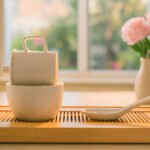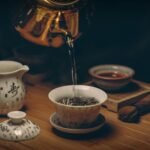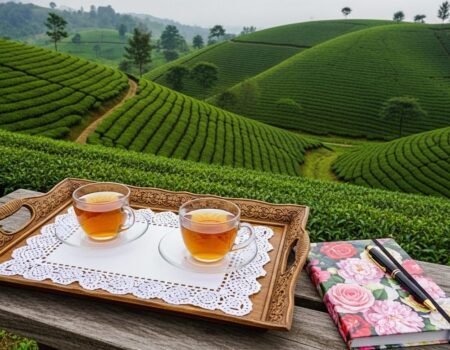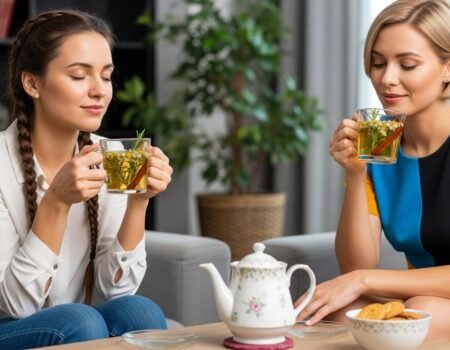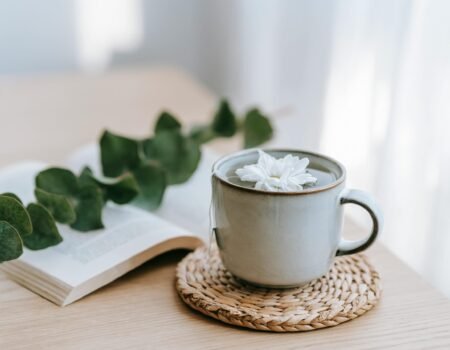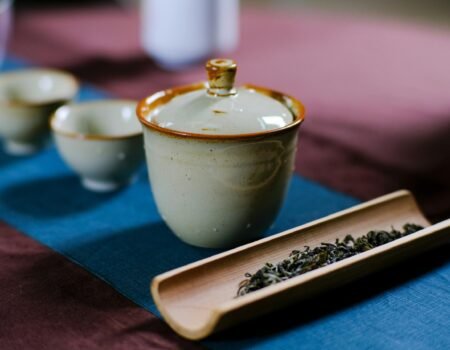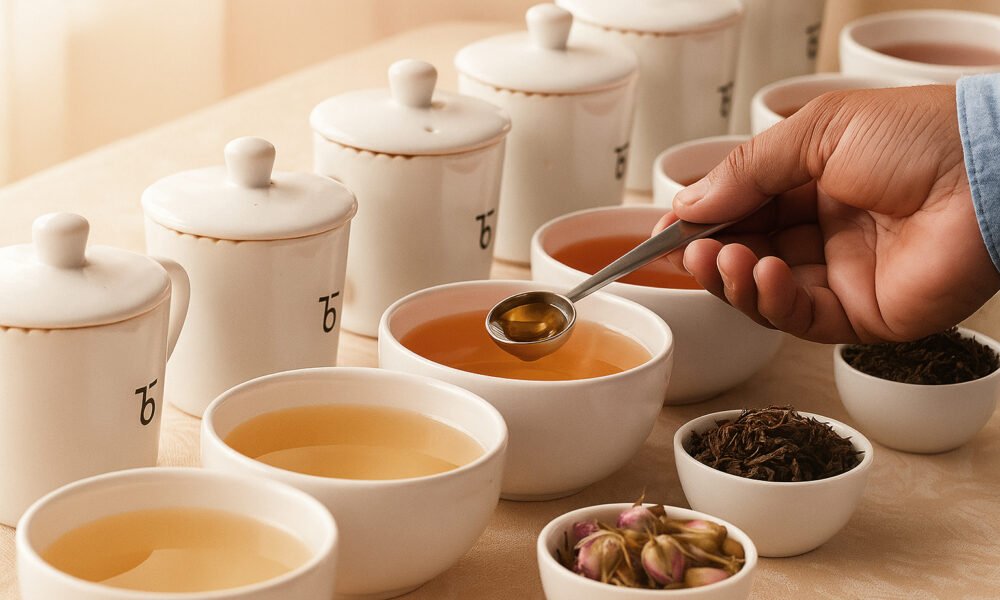
Mastering Tea Cupping Methods for the Perfect Brew
Index
Many tea lovers struggle to judge tea quality beyond simple likes and dislikes. Tea cupping methods offer a formal way to evaluate tea, just like wine tasting does for wine. This guide will teach you how to cup tea like a pro, from proper brewing to sensory analysis techniques.
Master these skills to unlock deeper flavors in every cup.
Key Takeaways
- Professional tea cupping relies on standardized measurements and timing to ensure a fair and consistent evaluation of a tea’s true qualities.
- Water quality greatly impacts tea flavor, with factors like pH level and mineral content affecting how different tea varieties taste during evaluation.
- The slurping technique aerates tea across your entire palate at once, helping you detect subtle flavors that might otherwise go unnoticed.
- Visual assessment includes examining dry leaves, infused leaves, and liquor color to judge quality before tasting begins.
- Developing a professional cupping palate requires regular practice with different tea types and keeping detailed notes to build your sensory memory.
Understanding Tea Cupping: Formal Evaluation
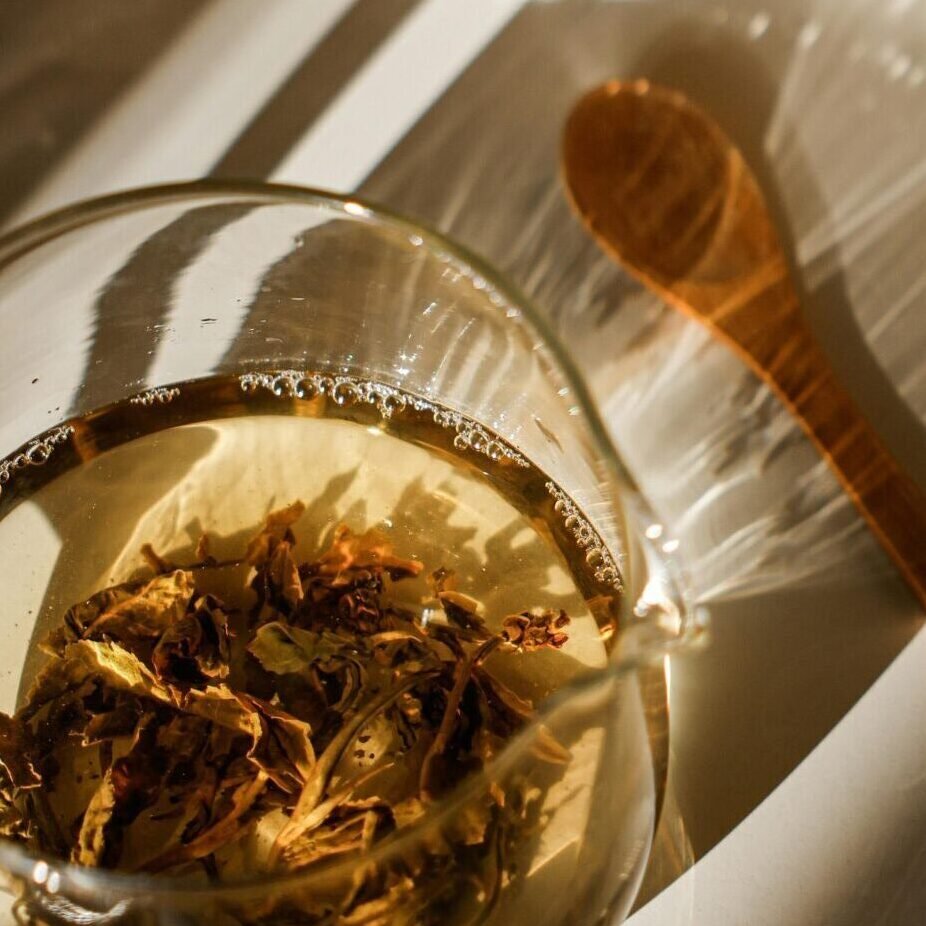
Tea cupping extends past casual brewing into formal taste assessment. Professional tasters use specific methods to judge tea quality, flavor profiles, and value in the market.
Defining Tea Cupping vs. Informal Tasting
Tea cupping stands apart from casual tasting through its structured approach to evaluation. Professional cuppers follow specific protocols to assess high-quality teas, focusing on complex flavor profiles rather than simple enjoyment.
This formal method uses standard equipment, precise measurements, and systematic steps like visual inspection of dry leaves and careful sensory analysis.
Informal tasting lacks these rigid standards and typically serves personal pleasure rather than critical assessment. While friends might share a pot of tea and discuss what they like about it, professional cuppers use specialized terms such as “briskness” to describe specific qualities.
The difference matters most to tea merchants, researchers, and serious collectors who need consistent ways to judge tea quality across different samples and varieties.
Objectives of Professional Tea Cupping
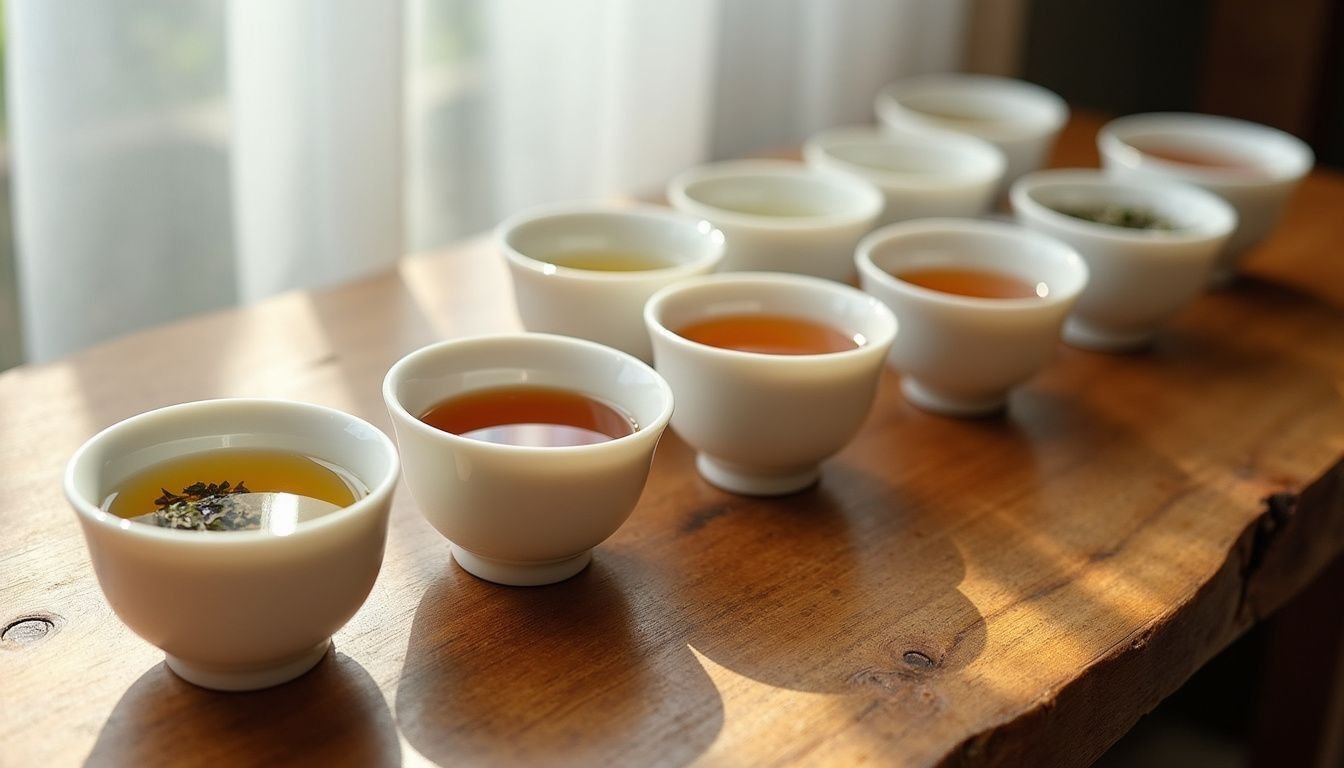
Moving beyond basic tea distinctions, professional tea cupping serves specific quality control purposes. Tea experts use cupping to judge tea samples against set standards for cafés and retailers.
They check each batch for consistent flavor profiles, which change based on growing region, farm practices, and seasonal factors. This strict testing helps buyers select teas that match their quality needs.
Professional cupping also reveals how flavors develop at different temperatures and steep times. Tasters follow a clear process: they inspect dry leaves, steep with exact measurements, and evaluate the tea’s body, texture, and aroma.
This method creates a common language among tea professionals to describe sensory qualities. The goal is to identify both outstanding teas and detect flaws that might affect customer satisfaction.
Standardization: The Foundation of Cupping
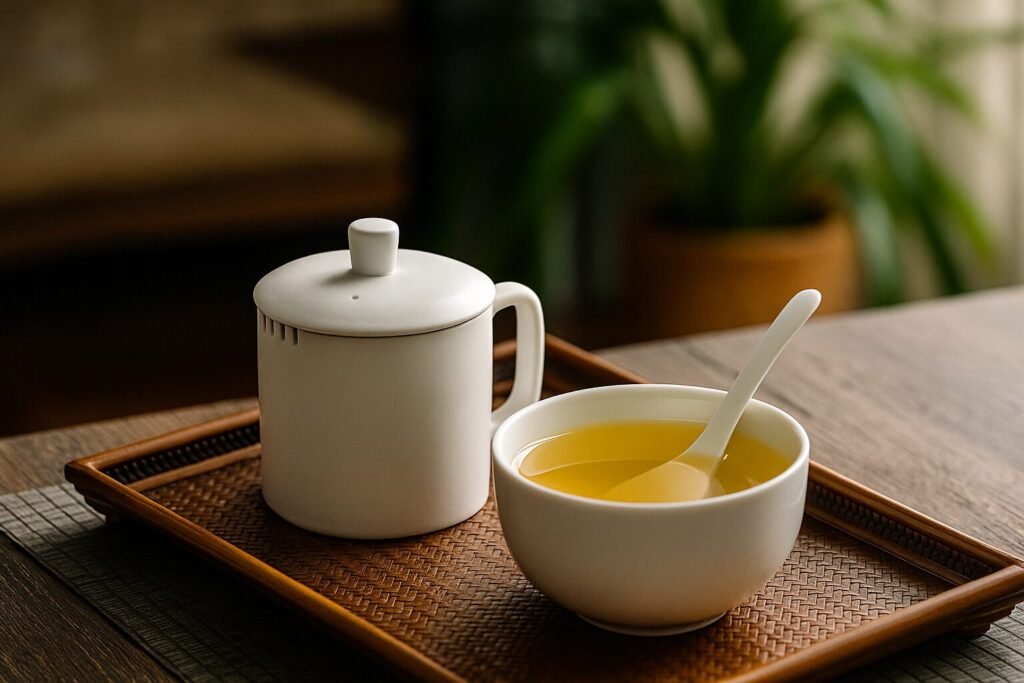
Standardized methods form the backbone of proper tea cupping, allowing tasters to compare samples fairly across time and place. These uniform practices help remove personal bias from the evaluation process and create a common language for tea professionals worldwide.
The Role of ISO 3103
ISO 3103 serves as the backbone of professional tea cupping worldwide. Created in the early 1980s, this international standard addresses the problem of subjective evaluations that once plagued the tea industry.
The protocol specifies exact measurements: 2 grams of tea leaf per 100 milliliters of water, steeped for exactly 6 minutes at 212°F/100°C. Tea experts follow these rules to judge each cup fairly and consistently.
This standard transforms tea tasting from a casual activity into a scientific process. Buyers, sellers, and researchers rely on ISO 3103 to compare different teas using the same baseline.
The strict parameters eliminate variables that might affect flavor perception, such as water temperature or steeping time. Professional cuppers can now focus on the true qualities of each tea type rather than differences in brewing methods.
While ISO 3103 serves as the official benchmark for laboratory assessment and bulk trade, you’ll find that most professional buyers, specialty-tea judges, and serious enthusiasts rarely follow it to the letter. The 6-minute steep at a full boil is designed to extract every possible compound—good and bad—for a stark scientific comparison.
However, for practical evaluation, tasters often use a shorter brew (typically around 3 minutes) and adjust water temperatures. This common professional practice prevents scalding delicate leaves and avoids the excessive bitterness a long steep can create, allowing the tea’s truer aroma and more nuanced flavors to shine.
For the remainder of this guide, we will master this real-world cupping method.
Essential Cupping Equipment and Setup
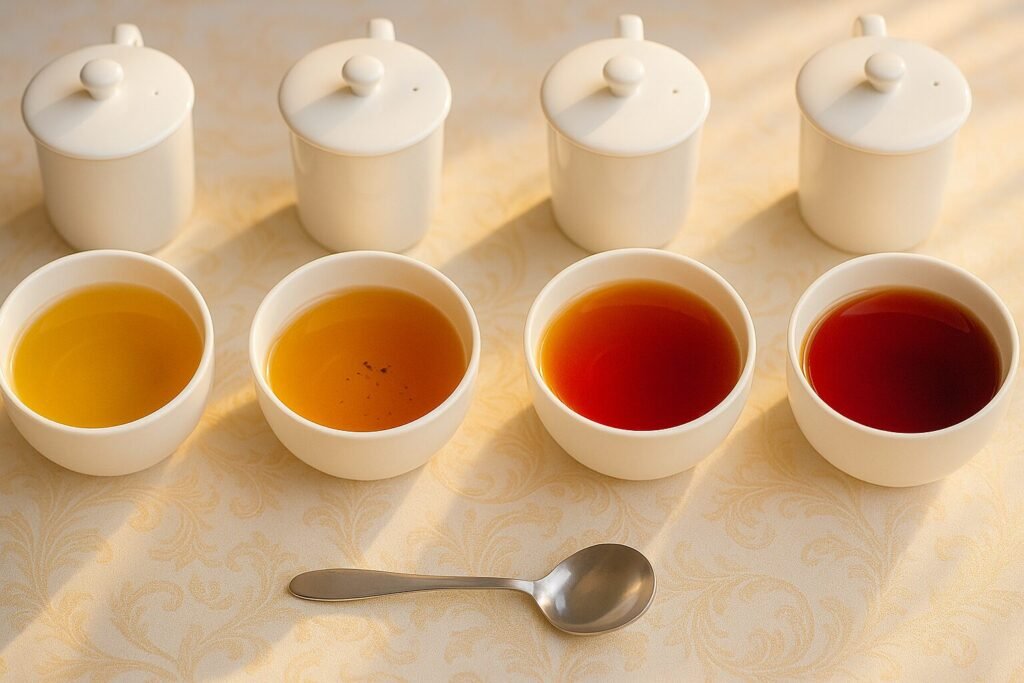
The right tools make all the difference in professional tea cupping. Setting up your cupping station requires specific equipment to ensure consistent evaluation results.
Core Brewing Equipment
- Cupping vessels: Use identical small bowls or cupping sets in white or clear material to assess liquor color accurately without flavor contamination
- Digital scale: Measure tea leaves precisely to the gram. For this method, we will use a standard of 3 grams of tea per 6 ounces (approx. 177ml) of water.
- Temperature-controlled kettle: Provide a consistent water temperature for all samples. For evaluation, a single temperature of 195°F (90.5°C) creates a neutral baseline for most tea types.
- Precision timers: Track steeping duration exactly, as even 30 seconds can drastically change flavor profiles
Tasting & Evaluation Tools
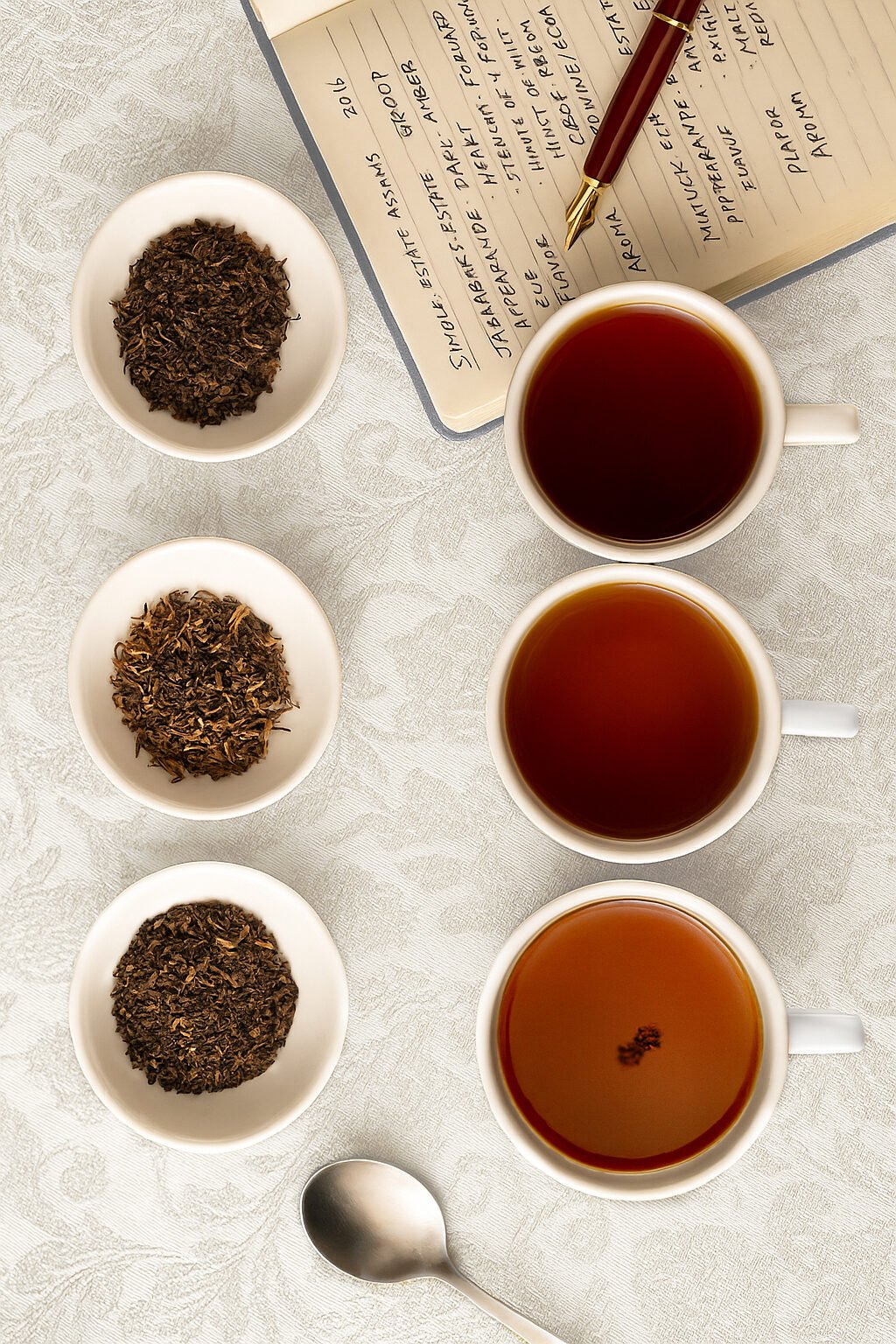
- Cupping spoons: Choose silver or stainless steel spoons with wide, shallow designs that maximize aroma capture during tasting
- Spittoons: Provide a place to discard samples after evaluation—vital during sessions with multiple tea types
- Neutral palate cleansers: Keep plain crackers or room temperature water on hand to reset taste buds between samples
Water & Environment Setup
- Filtered water: Use water with neutral pH to create a clean base that won’t mask tea flavors—water quality impacts taste more than any other brewing factor
- White evaluation mats: Create contrast for visual leaf assessment and help organize multiple samples during comparative tastings
Documentation
- Tasting notebooks: Document sensory observations about aroma, flavor, mouthfeel, and aftertaste—many tea masters use standardized evaluation forms
Critical Importance of Water Quality Parameters
Water quality makes or breaks your cup of tea. Pure, oxygenated water brings out the full flavor profile and delicate aromas that tea masters seek during evaluation. Different minerals in water interact with tea compounds, changing how you experience each sip.
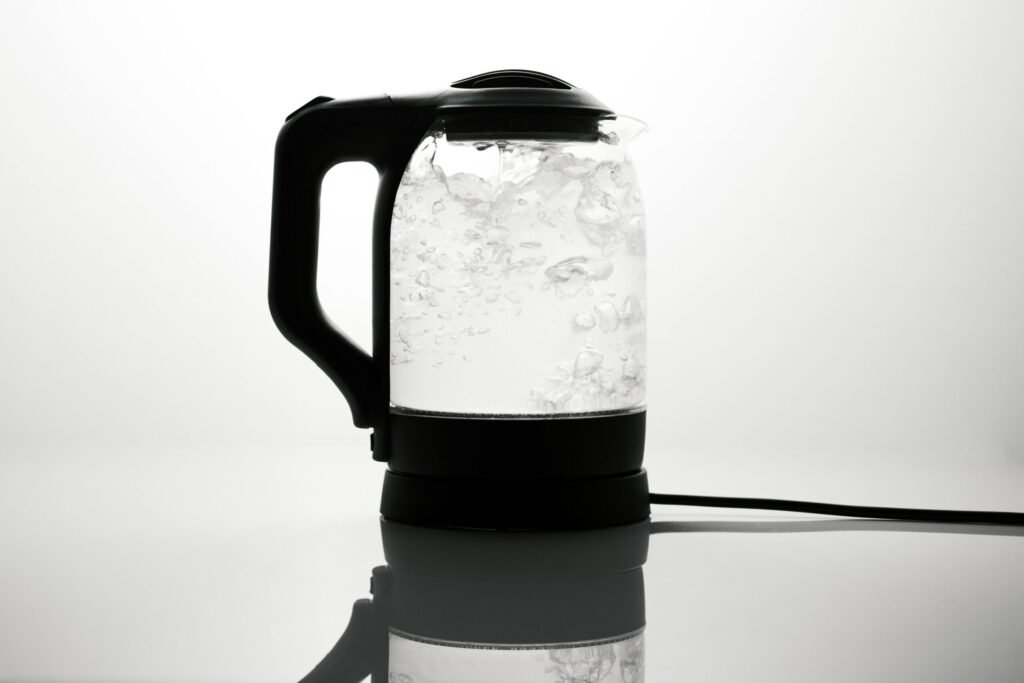
Hard water with high calcium levels can dull certain notes in delicate white teas, while soft water might fail to extract enough flavor from robust black teas like Keemun. Tea sommeliers pay careful attention to pH levels, mineral content, and oxygen levels to create consistent tasting conditions.
Consistency in water parameters allows for fair comparison between different tea varieties. Professional tea cupping requires this standardization to judge each tea on its true merits.
Many seasoned tea experts use filtered water with specific TDS (Total Dissolved Solids) measurements to remove chlorine, fluoride, and other contaminants that mask tea’s natural qualities.
While different teas are often brewed at various temperatures for casual drinking, professional cupping requires a single, consistent temperature to ensure a fair comparison. This precision ensures your sensory evaluation is focused only on the qualities of the tea leaf itself.
The Systematic Cupping Process: Techniques
Tea cupping follows a step-by-step method that turns tasting into a science. The following steps outline the common professional method we’ve discussed, balancing scientific rigor with the practical need to evaluate a tea’s ideal flavor profile.
We’ll show you how to measure tea precisely, control water temperature, and master the slurping technique that spreads flavor across your taste buds.
Preparation: Measuring and Brewing with Precision
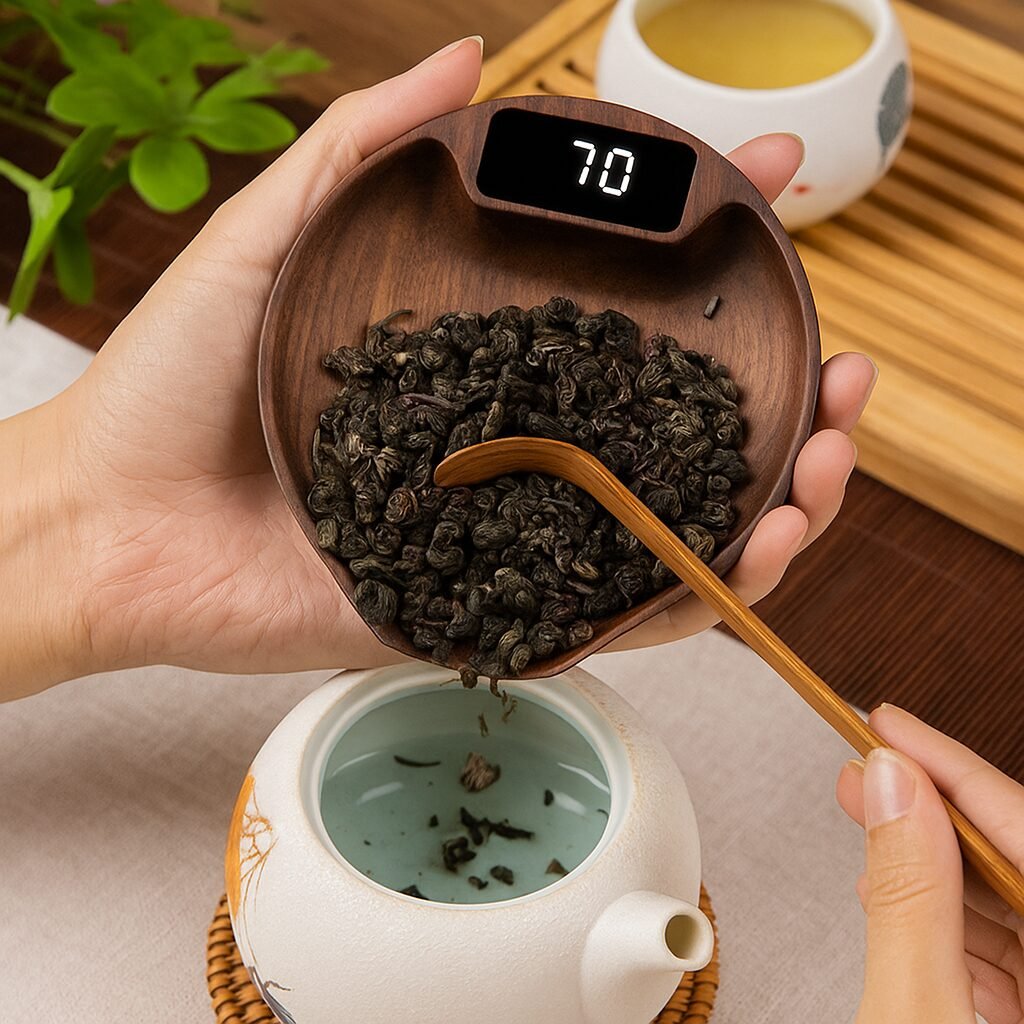
Precision matters greatly in tea cupping to ensure fair comparison between different teas. Accurate measurements and consistent brewing create the foundation for reliable evaluation results.
Professional Tea Cupping Setup
Essential Measurements & Equipment
- Digital scale precision: Weigh exactly 3 grams of tea for each 6-ounce cup to maintain the standard professional ratio
- Temperature control: Heat water to precisely 195°F using a temperature-controlled kettle—this temperature works well for most tea types during cupping
- Timing consistency: Set a timer for exactly 3 minutes across all samples
- Vessel uniformity: Use the same brewing vessel type for all samples to eliminate container material as a variable
Water & Brewing Technique
- Water quality: Select fresh, filtered water with neutral pH to avoid flavors that might mask the tea’s natural profile
- Pouring method: Pour water in a circular motion to ensure all leaves make contact with water simultaneously
- Straining decision: Strain leaves completely when comparing only the liquor, or leave them in to evaluate how flavors develop over time
Testing Environment & Process
- Sample preparation: Prepare multiple samples side by side rather than sequentially for identical brewing conditions
- Visual setup: Arrange cupping vessels on a clean, white surface to better observe liquor color without distractions
- Temperature timing: Allow brewed tea to cool slightly before evaluation—extreme temperatures can mask certain flavor notes
- Environmental control: Maintain consistent ambient temperature and humidity in your cupping space
Documentation
- Record keeping: Keep detailed notes about each measurement and brewing parameter to track variables that might affect results
The Slurping Technique: Maximizing Sensory Input
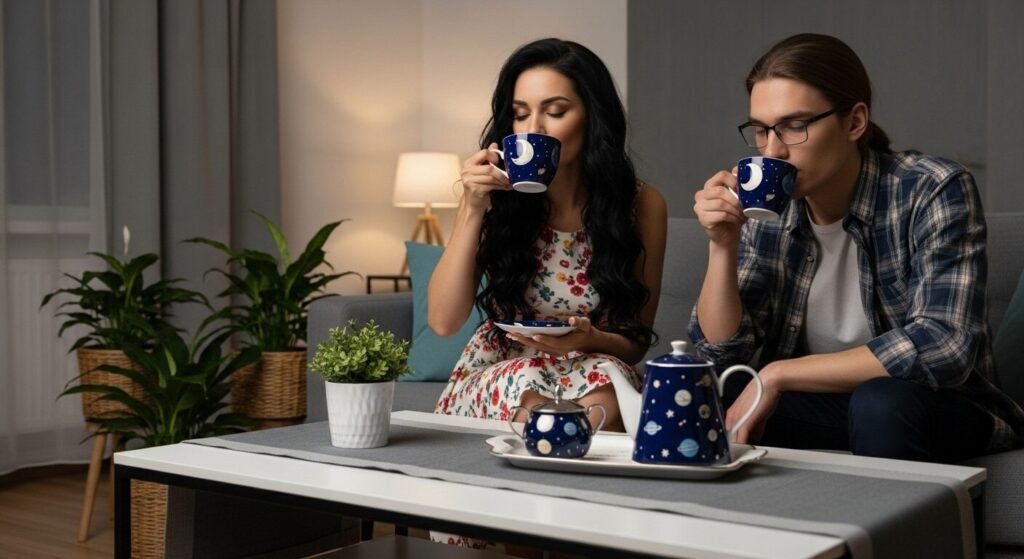
After measuring and brewing your tea with care, you need to master the art of slurping. Professional tea tasters don’t sip quietly—they slurp loudly and deliberately. This technique aerates the tea as it enters your mouth, spreading it across your entire palate at once.
The loud intake of air mixes with the liquid, enhancing flavor detection and allowing you to taste subtle notes that might otherwise go unnoticed. Tea experts practice this skill regularly to sharpen their sensory abilities, much like wine tasters do with their craft.
Your approach to each cup matters greatly for proper evaluation. Take a spoonful of brewed tea, draw it into your mouth with a quick, forceful inhalation, and let the flavors coat your tongue.
The sound might seem impolite in normal settings, but in professional tea cupping, it serves a crucial purpose. Different types of tea—from delicate silver needle white tea to full-bodied keemun black tea—reveal their unique characteristics more fully through this method.
The goal isn’t just drinking tea but truly experiencing its complete flavor profile.
Sensory Evaluation Criteria in Detail
Sensory evaluation forms the backbone of professional tea assessment, requiring a trained palate and systematic approach. Tea cupping involves detailed analysis across visual, smell, and taste dimensions that reveal the true character of each leaf.
Visual Assessment: Dry Leaf, Infused Leaf, and Liquor
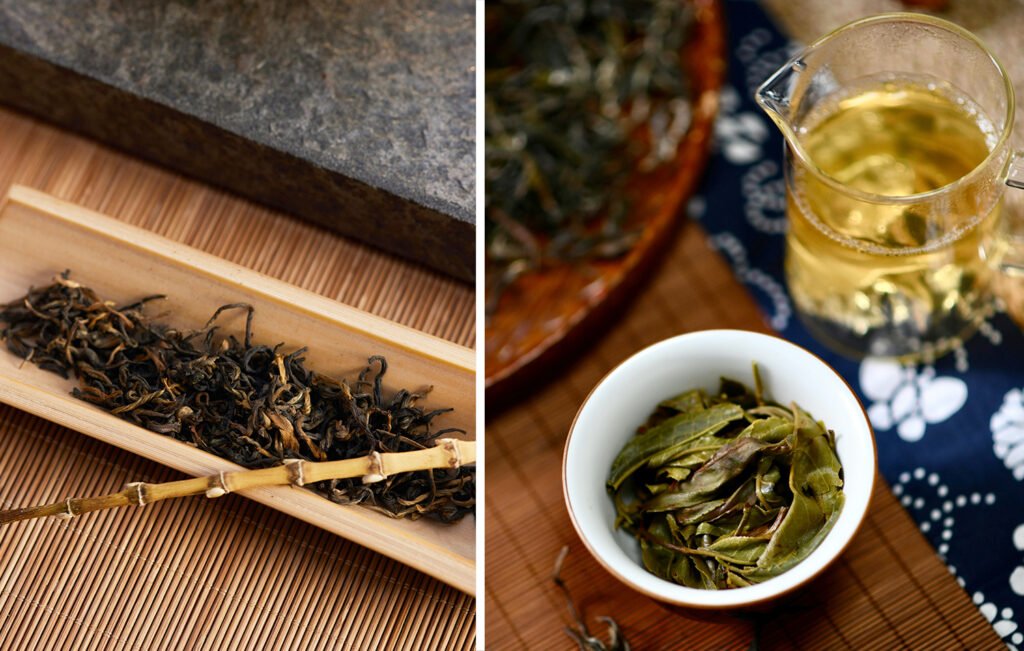
Professional tea cupping starts with a careful look at the dry leaves. You need to check quality, color, size, and texture of each sample. High-quality Keemun black tea shows dark blackish-brown leaves with a well-twisted shape, while lower-quality options appear faded or old.
The dry leaf stage gives you your first clues about processing methods and overall tea quality.
Next comes the evaluation of infused leaves and liquor. After brewing, spread the wet leaves on a white plate to study their appearance and smell. Experts use terms like “bright,” “coppery,” and “even” to describe what they see.
The liquor assessment focuses on color clarity and brightness in the cup. This visual step creates a foundation for the tasting that follows and helps identify specific tea varieties from oolong to yellow tea.
Olfactory Assessment: Dry, Hot, Warm, and Cold Aromas
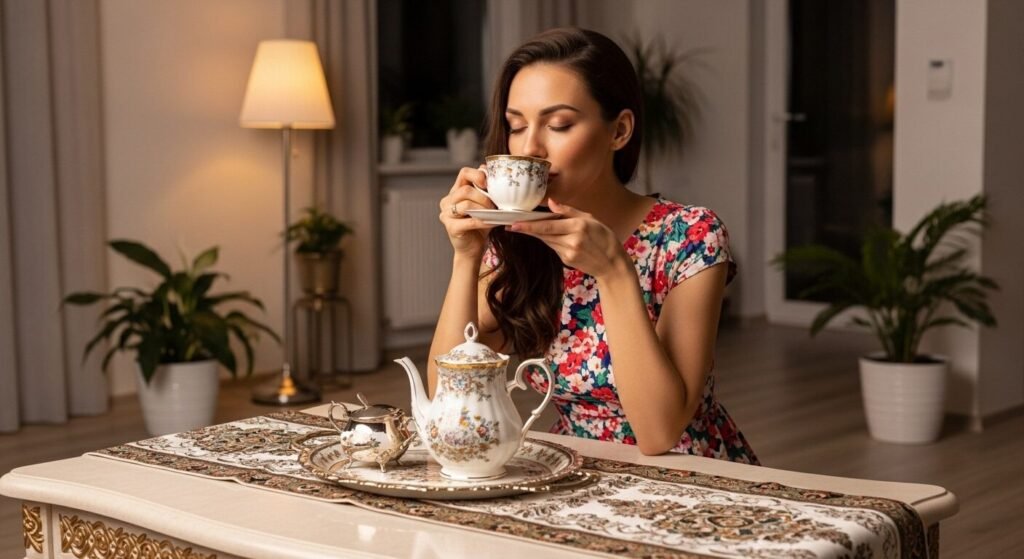
Your nose reveals tea secrets before your first sip. We start by smelling dry leaves to detect their basic character. The tea processing method creates specific scents – floral notes in white teas like Baihao Yinzhen, fruity hints in oolongs, or oceanic scents in Japanese Gyokuro.
Next comes hot aroma evaluation as water first hits the leaves, releasing volatile compounds that signal quality. The warm phase occurs during brewing, while cold assessment happens after the tea cools.
Each temperature stage unlocks different aroma compounds.
Tea experts check if leaf aromas match cup flavors, which indicates proper processing. The nose also spots defects such as chemical smells or storage problems that might ruin your tea experience.
Different tea varieties require specific evaluation approaches – loose leaf teas often need more careful assessment than tea bags. This sensory step forms a critical part of the cupping process, helping distinguish specialty teas from ordinary ones.
Gustatory Assessment: Flavor, Mouthfeel, and Aftertaste

After noting the tea’s aromatic qualities, we turn our attention to taste – the most revealing aspect of tea evaluation. Flavor assessment involves identifying primary taste notes such as sweet, sour, bitter, salty, and umami present in the liquor.
Professional tasters slurp tea loudly to spread it across all taste receptors, maximizing sensory input for a complete flavor profile.
Tea body ranges from light to heavy, while mouthfeel describes specific tactile sensations like drying, juicy, sticky, buttery, or creamy. The finish – those lingering flavors that remain after swallowing – offers crucial insights into tea quality.
Great teas display balance between these elements, with sweetness complementing astringency and a pleasant finish that evolves over time. Many specialty tea drinkers prize this aftertaste, which can persist for several minutes in exceptional teas like pu’er or high-grade oolong.
The Professional Taster’s Lexicon
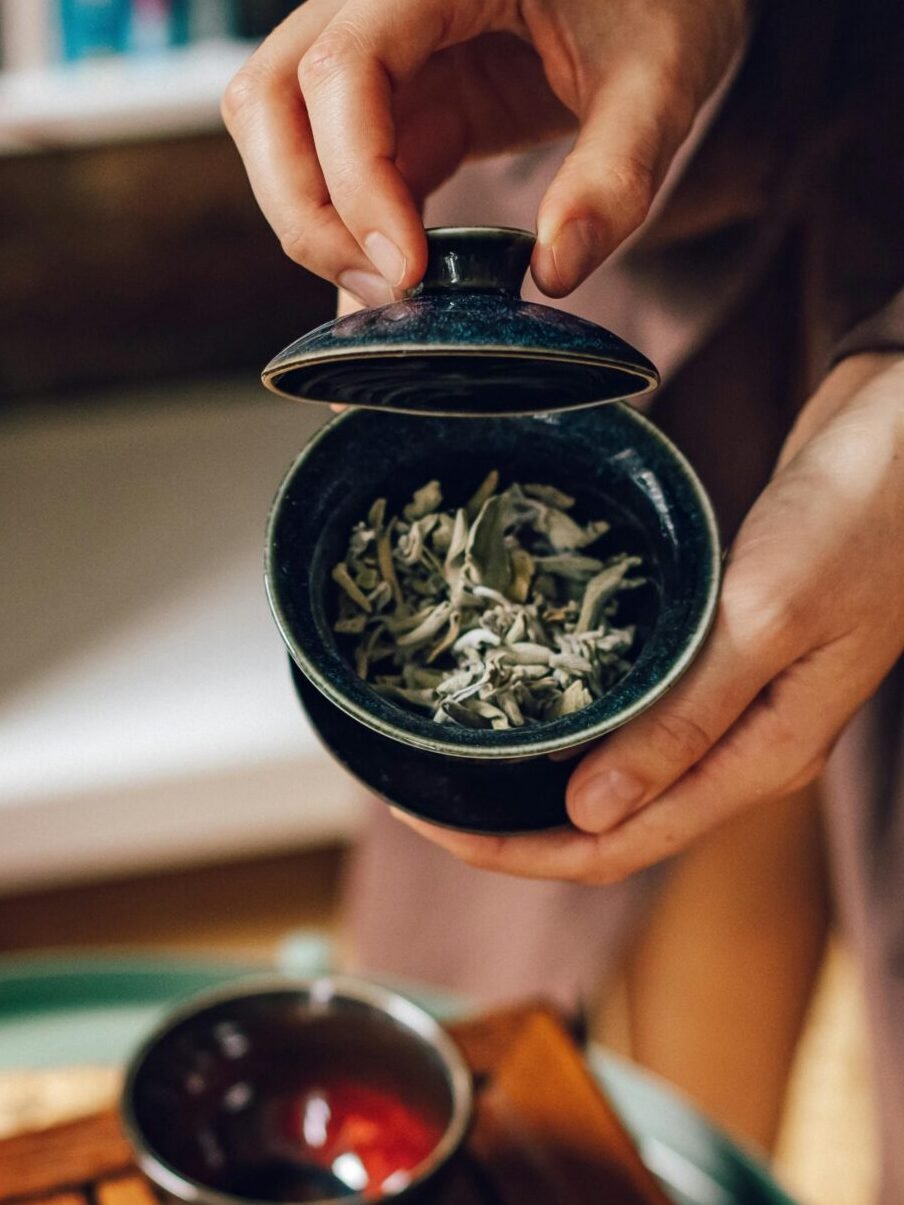
Learn the exact words tea pros use to talk about tea quality and taste – from leaf shape to liquor brightness – and speak their language to judge each cup like an expert.
Key Terminology for Describing Leaf Characteristics
Tea professionals use specific words to judge dry leaves before brewing. “Attractive” leaves show good color and shape, while “chunky” describes larger, broken pieces. We assess uniformity, noting if leaves appear “even” in size and color.
The appearance tells us about tea quality and proper processing methods.
Tea leaf grading relies on visual markers that signal quality. Bright, coppery hues often indicate freshness in black teas, while dull colors might suggest improper storage. Size matters too—smaller, consistent leaves typically brew more evenly than irregular ones.
Professional cuppers examine these traits with careful attention, as leaf characteristics directly impact the final cup’s flavor profile.
Key Terminology for Describing Liquor Attributes
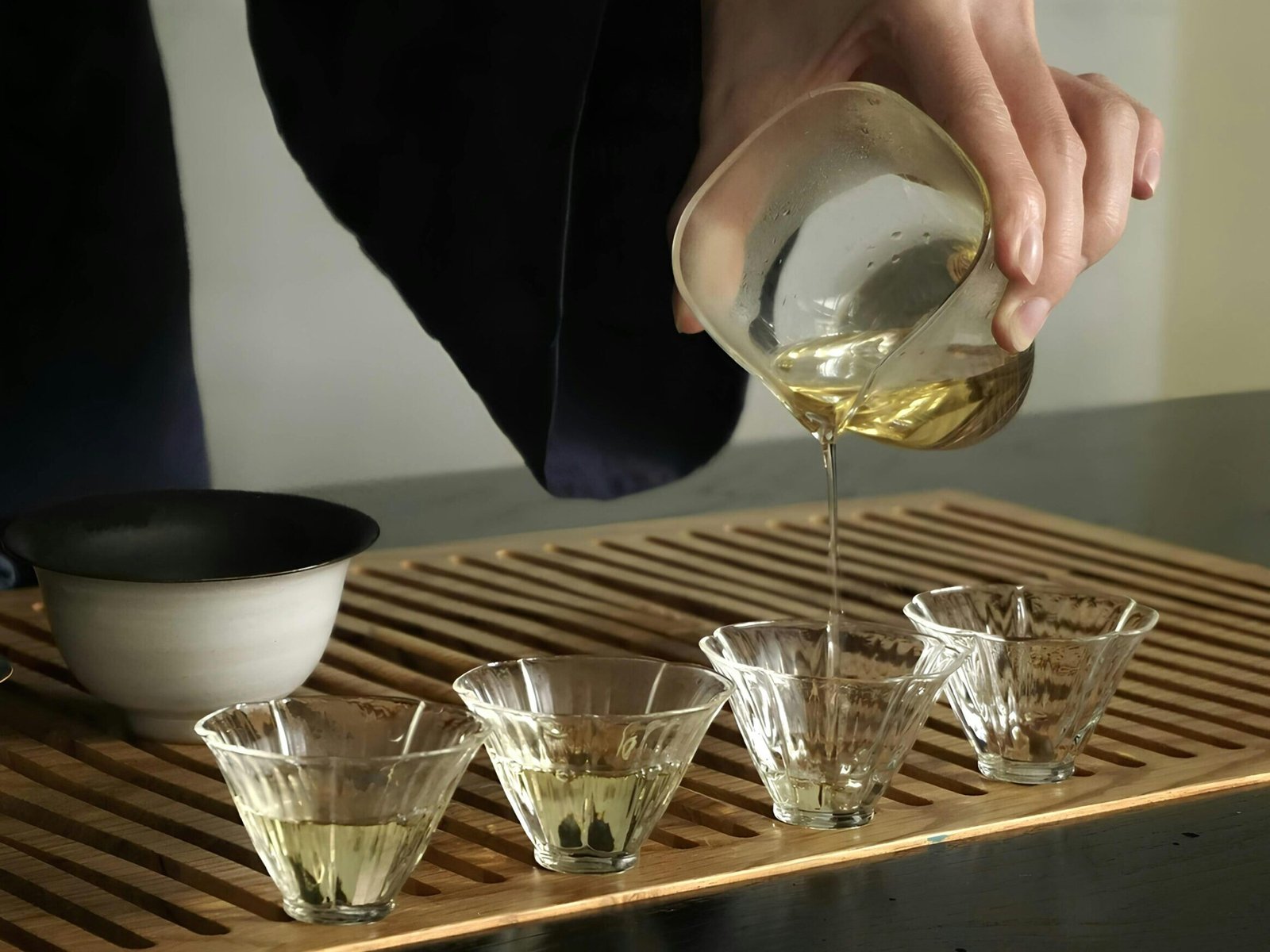
While leaf characteristics tell part of the story, the tea’s liquor reveals its true character. Tea tasters use specific language to capture what they find in each cup. Body refers to the tea’s weight or thickness in your mouth, ranging from light to full.
Brightness describes the tea’s clarity and liveliness on the palate. Briskness points to a clean, refreshing quality that makes good tea invigorating. Harshness signals negative astringency that creates an unpleasant mouth-puckering effect.
You’ll notice professional cuppers also assess acidity levels, similar to wine tasting, which adds complexity to the perfect cup. They track how flavors develop from first sip through the aftertaste.
The mouthfeel might be smooth, astringent, or velvety depending on the tea variety and brewing method. Learning this vocabulary helps you better understand what makes each tea unique and allows you to communicate your own tasting experiences with precision.
Many tea masters spend years training their palates to detect these subtle differences across different processing methods.
Cultivating a Professional Cupping Palate
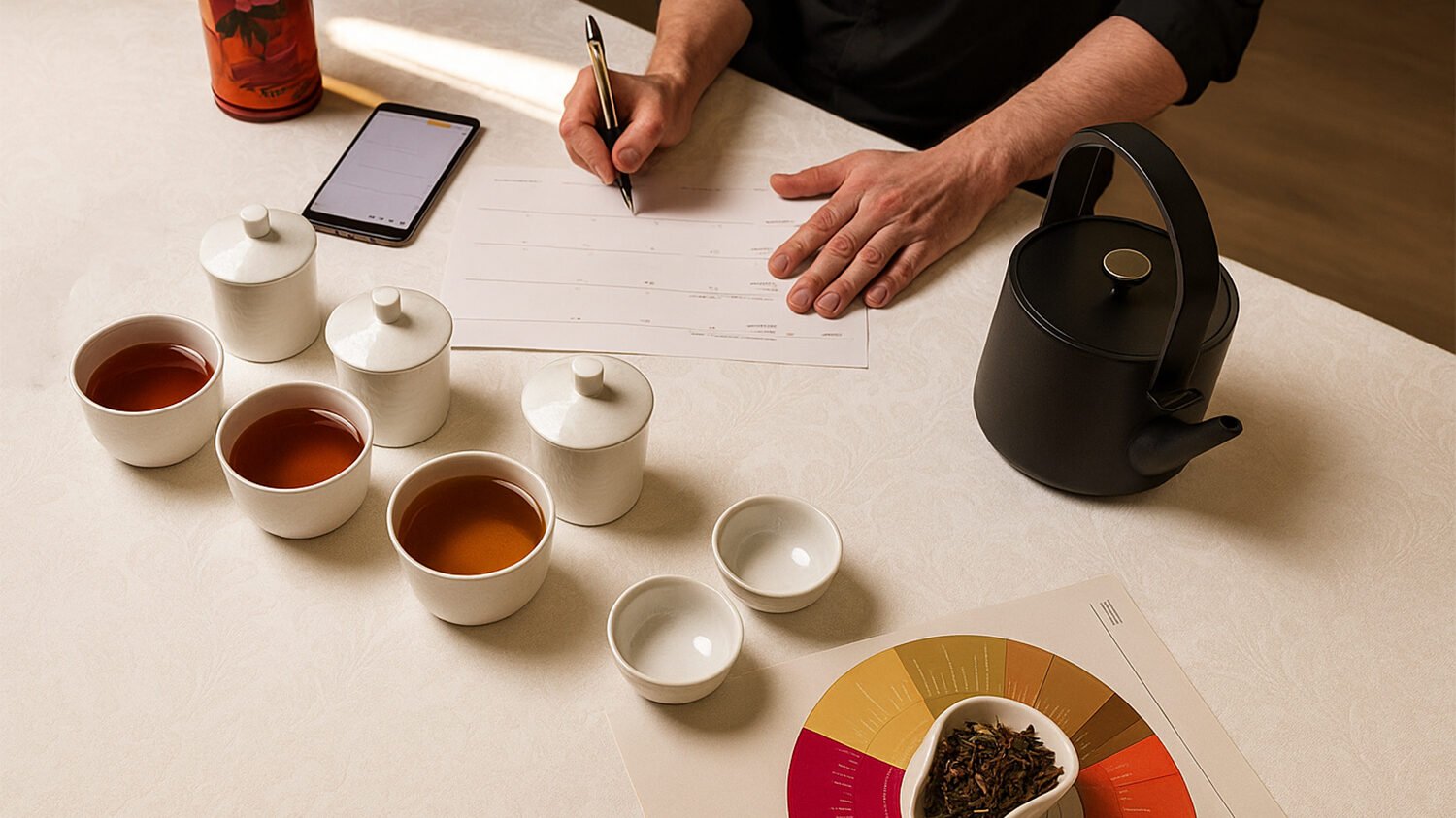
Developing a professional tea cupping palate takes practice and patience. You must taste many types of tea regularly to train your senses to detect subtle differences. Start with just three teas per session using white porcelain cups that show true liquor color and prevent flavor contamination.
Each person needs their own spoon to avoid mixing flavors during evaluation. High-quality spring water makes a big difference in bringing out authentic tea notes.
Your palate grows stronger through consistent tasting exercises focused on specific aspects like mouthfeel or aftertaste. Tea masters suggest comparing similar teas side by side, such as different assam varieties or loose tea from various regions.
Take notes during each session using standard terms from the professional taster’s lexicon. This builds your sensory memory and helps you communicate your findings clearly. The best tasters can identify brewing time differences down to 30-second intervals after months of dedicated practice.
Conclusion
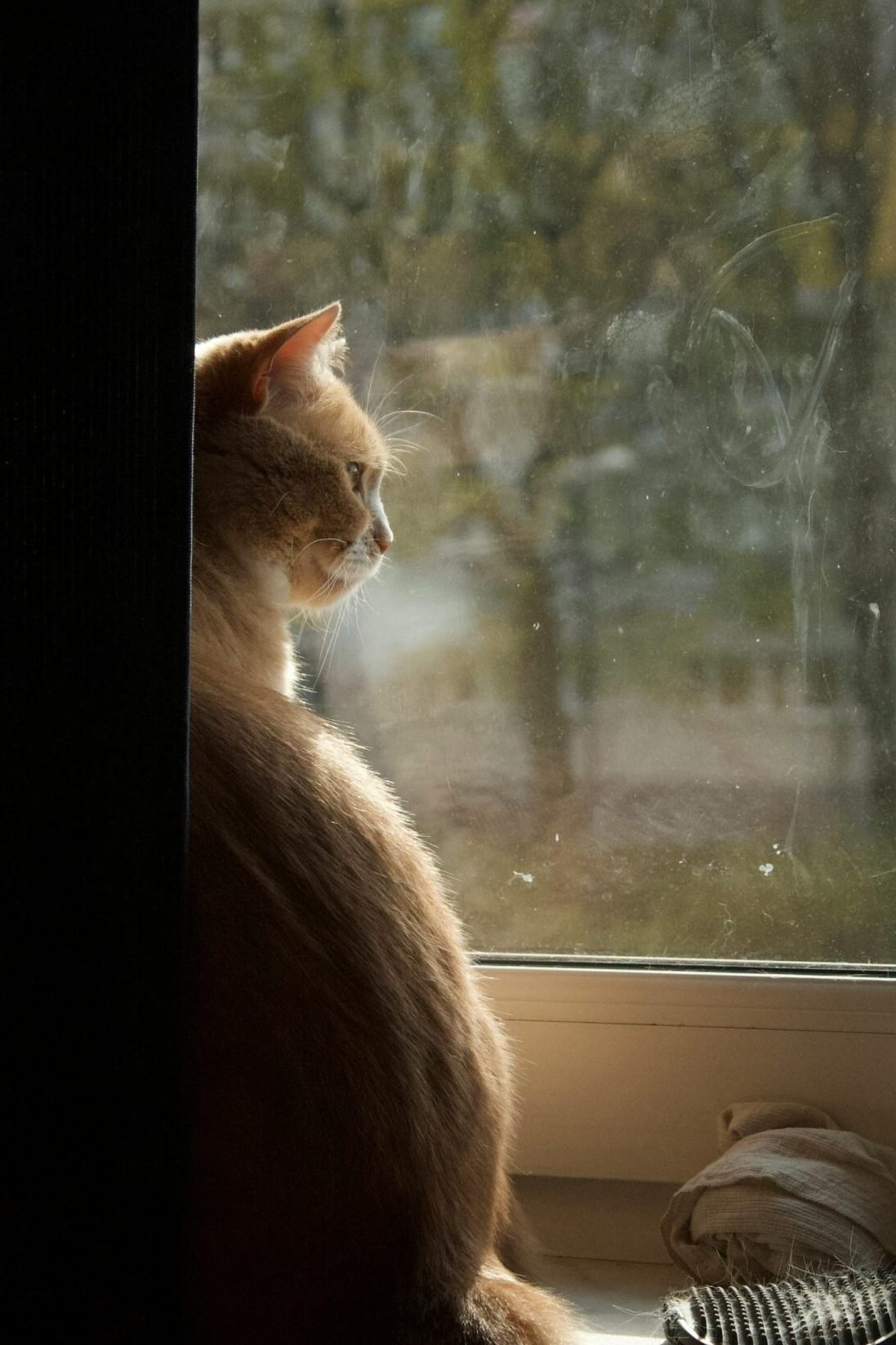
Tea cupping opens a gateway to deeper tea appreciation through careful practice and attention. Your skills will grow with each session as you train your senses to detect subtle flavors and aromas.
Regular cupping helps you build a mental library of tea profiles, making you more confident in your brewing choices. The methods we’ve explored serve both casual drinkers and serious enthusiasts looking to understand what makes each cup special.
Master these techniques, and you’ll transform ordinary tea drinking into a rich sensory journey worth savoring every day.
FAQs
1. What is tea cupping and why is it important for making the perfect cup of tea?
Tea cupping is a method of evaluating tea by examining its aroma, flavor, and appearance. We use this technique to understand different types of tea better, much like wine tasting. It helps you brew the perfect cup by revealing the unique characteristics of each tea.
2. How much tea should I use when preparing tea for cupping?
Our recommended standard for cupping is 3 grams of tea per 6 ounces (approx. 177ml) of water. This precise ratio provides a clear and consistent expression of the tea’s character for fair evaluation.
3. What’s the ideal brewing time for tea cupping?
For practical, professional cupping, the ideal time is exactly 3 minutes. Unlike the 6-minute ISO standard designed for scientific lab analysis, this shorter steep is used by industry experts to evaluate a tea’s flavor as it’s meant to be enjoyed.
It effectively reveals the tea’s full character and any potential flaws without introducing the excessive bitterness that can mask subtle notes.
4. How does Gongfu Cha differ from regular tea cupping methods?
Gongfu Cha is a Chinese tea culture method using more tea leaves with shorter steeping times. It requires special teaware and focuses on multiple infusions to explore how tea flavors develop across brews.
5. Can I apply coffee cupping techniques to tea evaluation?
While coffee and tea evaluation share similarities, tea requires different temperature considerations and has more subtle flavor notes. Tea doesn’t undergo roasting like coffee, so we focus more on leaf quality and processing methods instead of roast profiles.
6. Is cold-brew tea suitable for cupping new teas?
Cold-brew methods aren’t ideal for initial tea cupping. Hot water extraction reveals more complete flavor profiles that help tea drinkers develop a deeper understanding of tea qualities. Save cold-brewing for after you’ve evaluated the tea traditionally.
References
- https://perfectdailygrind.com/2017/09/specialty-tea-an-introduction-to-tea-cupping/
- https://tching.com/2013/09/tea-cupping-versus-tea-tasting/ (2013-09-11)
- https://siamteas.com/siam-teabloid-2/siam-teabloid-vol-2024/the-secrets-of-professional-tea-tasting/ (2024-09-17)
- https://jyyna.co.uk/iso-3103/
- https://www.teasmart.com/article_220506.html
- https://www.researchgate.net/publication/312183310_Water_for_Extraction-Composition_Recommendations_and_Treatment
- https://www.royalny.com/cupping-tea/
- https://www.tankcoffee.com/mastering-the-coffee-cupping-technique/ (2024-02-26)
- https://pmc.ncbi.nlm.nih.gov/articles/PMC11593154/
- https://www.teadrunk.com/blogs/educational-articles/tea-sensory-analysis-from-aroma-to-aftertaste?srsltid=AfmBOoo0c5ahbZk5jZ_CzMmKeH-MKyie9wYI3MBQILEAL9OJOyl-c1T5
- https://www.teacupsfull.in/blogs/blog/tea-tasting-terminology-and-its-meaning?srsltid=AfmBOooHbTyF0W3-FPP0ukUoUSJQo_7-9ceBjvtjyVOOXfADx_vKm6nL
- https://www.teacupsfull.in/blogs/blog/tea-tasting-terminology-and-its-meaning?srsltid=AfmBOor7zrsjaPLh109GnfoJCODBFLj5jGxeLZwsgAbgwPLS_jXr2oLU
- https://www.cupabovetea.com/blogs/cup-above-tea/tea-terminology-the-language-of-tea-tasting

